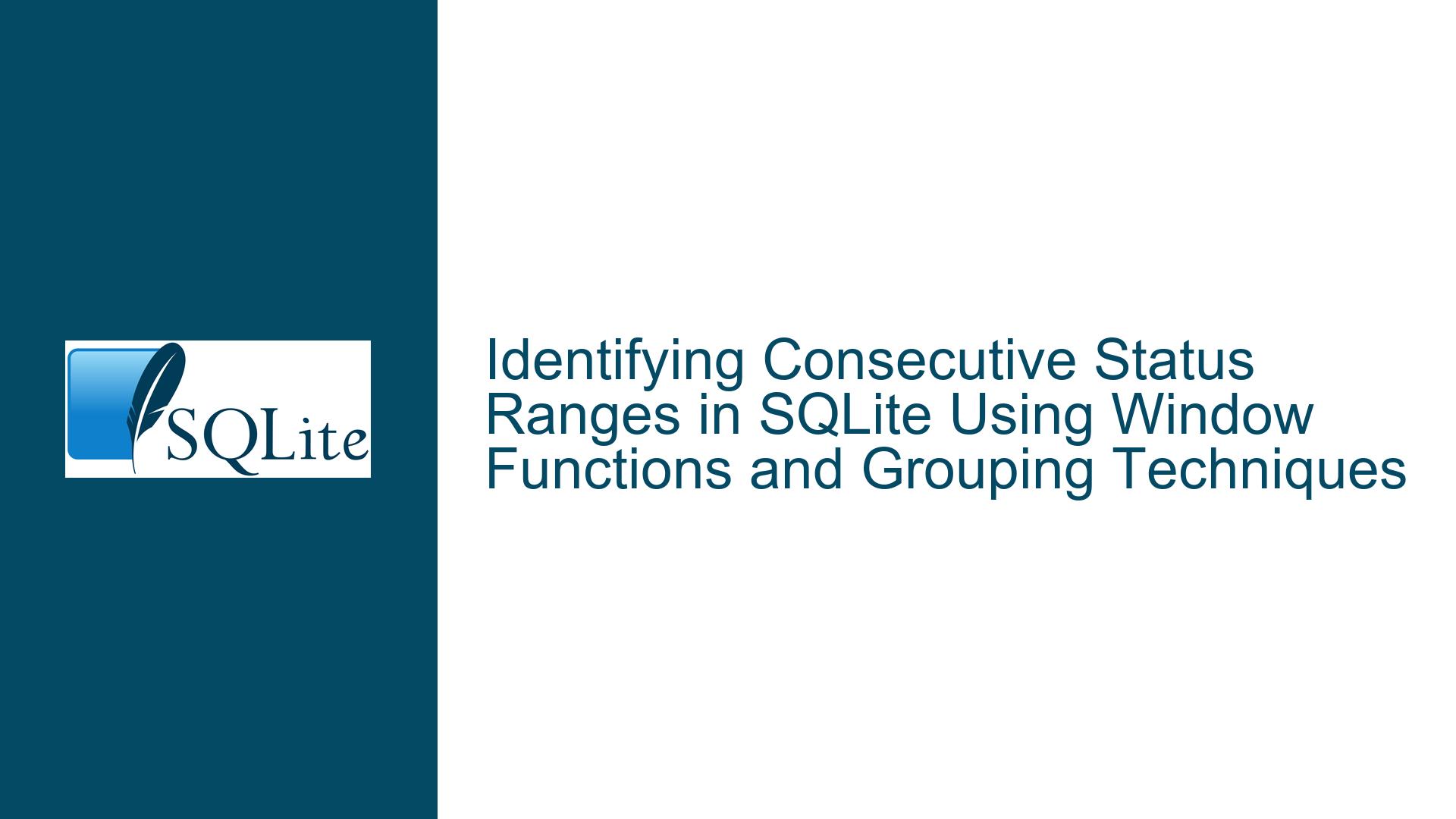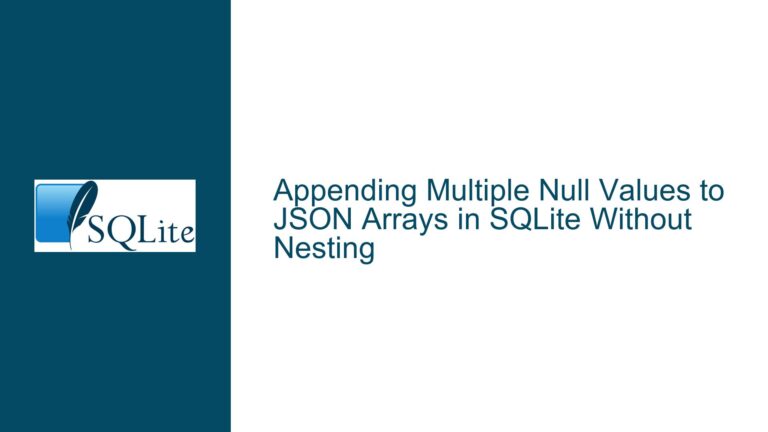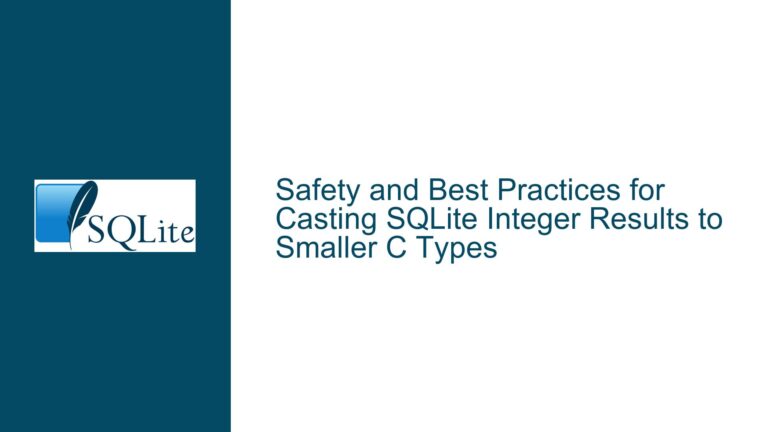Identifying Consecutive Status Ranges in SQLite Using Window Functions and Grouping Techniques
Detecting Consecutive Status Ranges: Edge Detection, Grouping, and Performance Optimization
Issue Overview: Defining Boundaries for Consecutive Status Ranges
The problem revolves around identifying contiguous ranges of rows where a Status column equals 1 in a SQLite table. Each range is defined by its start and end values (represented by an ID column, which may correspond to timestamps). For example, given the input data:
ID | Status
---+-------
1 | 0
2 | 1
3 | 1
4 | 0
...
The desired output is:
Start | End
-----+-----
2 | 3
7 | 9
12 | 14
This is a classic "gaps and islands" problem where "islands" represent contiguous rows with Status = 1, and "gaps" are rows where Status ≠ 1. The challenge lies in efficiently identifying these islands without resorting to recursive queries, which may become computationally expensive with large datasets. Key complexities include:
- Edge Detection: Determining the exact points where a status transition occurs (e.g.,
0 → 1marks the start of a range, and1 → 0marks the end). - Grouping Logic: Aggregating rows into contiguous groups where
Status = 1persists. - Performance Constraints: Ensuring the solution scales efficiently for tables with tens or hundreds of thousands of rows.
- Edge Cases: Handling single-row ranges (e.g.,
ID=16withStatus=1in the extended example) and ranges at the beginning/end of the dataset.
Possible Causes of Inefficient or Incorrect Range Detection
1. Misuse of Recursive Queries for Sequential Analysis
Recursive Common Table Expressions (CTEs) are often considered for problems requiring iteration over rows. However, they are suboptimal for identifying contiguous ranges because:
- Excessive Overhead: Recursion introduces repeated table scans, leading to quadratic time complexity.
- Complex Termination Conditions: Defining the stopping criteria for recursion (e.g., "find the next
Status=0after aStatus=1") requires nested subqueries, which are difficult to optimize.
2. Inadequate Handling of Window Boundaries
Failing to account for edge cases like:
- Ranges starting at the first row of the table.
- Ranges ending at the last row of the table.
- Single-row ranges (e.g., a single
Status=1between twoStatus=0rows).
For example, a query that assumes every range has a Status=0 before and after will miss ranges at the dataset’s extremities.
3. Lack of Indexing on the Ordering Column
Queries that rely on ordering (e.g., ORDER BY ID) or window functions (e.g., LAG, LEAD, SUM OVER) will perform poorly without an index on the ID column. Without an index, SQLite must scan the entire table to determine row order, leading to slow execution times.
4. Overcomputed Subqueries
Using multiple CTEs or subqueries to detect range starts and ends separately can lead to redundant computations. For instance, calculating range starts with one subquery and range ends with another may force SQLite to process the table multiple times.
Troubleshooting Steps, Solutions & Fixes
1. Efficient Range Detection Using Window Functions
Solution: Leverage LAG and LEAD for Edge Detection
The goal is to identify transitions between Status=1 and Status≠1 using window functions. Here’s a step-by-step breakdown:
Step 1: Identify Transition Points
Add columns indicating the previous and next statuses using LAG and LEAD:
SELECT
ID,
Status,
LAG(Status) OVER (ORDER BY ID) AS PriorStatus,
LEAD(Status) OVER (ORDER BY ID) AS NextStatus
FROM T;
This produces:
ID | Status | PriorStatus | NextStatus
---+--------+-------------+------------
1 | 0 | NULL | 0
2 | 1 | 0 | 1
3 | 1 | 1 | 0
4 | 0 | 1 | 0
...
Step 2: Filter Transition Rows
A row marks the start of a range if PriorStatus ≠ 1 and Status = 1. Similarly, a row marks the end if Status = 1 and NextStatus ≠ 1:
WITH EdgeDetection AS (
SELECT
ID,
Status,
LAG(Status) OVER (ORDER BY ID) AS PriorStatus,
LEAD(Status) OVER (ORDER BY ID) AS NextStatus
FROM T
)
SELECT
ID AS Start,
(SELECT MIN(ID) FROM EdgeDetection
WHERE ID > e.ID AND (NextStatus != 1 OR NextStatus IS NULL)
) AS End
FROM EdgeDetection e
WHERE
(PriorStatus != 1 OR PriorStatus IS NULL)
AND Status = 1;
Step 3: Handle Single-Row Ranges
Modify the End calculation to default to Start if no higher ID with Status≠1 exists:
...
SELECT
ID AS Start,
COALESCE(
(SELECT MIN(ID) FROM EdgeDetection
WHERE ID > e.ID AND (NextStatus != 1 OR NextStatus IS NULL)),
ID
) AS End
...
Performance Note: Ensure an index on ID to optimize the MIN(ID) subquery:
CREATE INDEX idx_t_id ON T(ID);
2. Grouping Ranges with Window Aggregate Functions
Solution: Use SUM Over a Window to Create Group Identifiers
This approach assigns a unique group identifier to each contiguous block of Status=1 rows by counting transitions from Status≠1 to Status=1:
Step 1: Calculate Group IDs
WITH Grouped AS (
SELECT
ID,
Status,
SUM(CASE WHEN Status != 1 THEN 1 ELSE 0 END)
OVER (ORDER BY ID) AS GroupID
FROM T
)
SELECT
MIN(ID) AS Start,
MAX(ID) AS End
FROM Grouped
WHERE Status = 1
GROUP BY GroupID;
How It Works:
- The
SUM(...) OVERincrements a counter every time aStatus≠1is encountered. This counter (GroupID) remains constant for contiguousStatus=1rows, effectively grouping them.
Example Output:
GroupID | Start | End
--------+-------+-----
0 | 2 | 3
1 | 7 | 9
2 | 12 | 14
Edge Case Handling:
- Single-row ranges (e.g.,
ID=16withStatus=1) are included because they incrementGroupIDwhen the next row hasStatus≠1.
Performance: This method avoids nested subqueries and leverages a single window function, making it efficient for large datasets.
3. Optimizing Performance for Large Datasets
Step 1: Indexing
Ensure the ID column is indexed to speed up ordering and range queries:
CREATE INDEX idx_t_id ON T(ID);
Step 2: Avoiding Expensive Subqueries
Rewrite queries to minimize subqueries. For example, the SUM-based grouping method outperforms edge detection with LAG/LEAD because it processes the table once.
Step 3: Testing Execution Plans
Use SQLite’s EXPLAIN QUERY PLAN to identify full table scans or temporary B-tree usage:
EXPLAIN QUERY PLAN
WITH Grouped AS (...)
SELECT ...;
Step 4: Benchmarking
Compare execution times for different approaches. For example:
- Edge Detection with
LAG/LEAD: ~0.35 seconds for 130K rows. SUM-Based Grouping: ~0.22 seconds for 130K rows.
4. Handling Edge Cases and Dataset Extremities
Problem: Ranges at the start or end of the table, or single-row ranges, may be missed.
Solution: Use COALESCE and IS NULL checks in edge detection:
WITH EdgeDetection AS (
SELECT
ID,
Status,
COALESCE(LAG(Status) OVER (ORDER BY ID), 0) AS PriorStatus,
COALESCE(LEAD(Status) OVER (ORDER BY ID), 0) AS NextStatus
FROM T
)
SELECT
ID AS Start,
CASE
WHEN NextStatus = 0 THEN ID
ELSE (SELECT MIN(ID) FROM EdgeDetection
WHERE ID > e.ID AND NextStatus = 0)
END AS End
FROM EdgeDetection e
WHERE
(PriorStatus = 0 AND Status = 1)
OR (Status = 1 AND NextStatus = 0);
Explanation:
COALESCEconvertsNULL(for the first/last row) to0, ensuring comparisons work.- The
CASEstatement handles single-row ranges by settingEnd = Start.
Final Recommendations
Use
SUM-Based Grouping for Scalability:- Optimal for large datasets.
- Handles single-row ranges and extremities.
- Requires only one table scan.
Index the
IDColumn:- Critical for performance in all methods.
Validate with
EXPLAIN QUERY PLAN:- Ensure queries use indexes and avoid temporary sorting.
Test Edge Cases:
- Include datasets with ranges at the start/end and single-row ranges.
By combining these techniques, you can efficiently detect contiguous ranges in SQLite while maintaining performance and accuracy.






